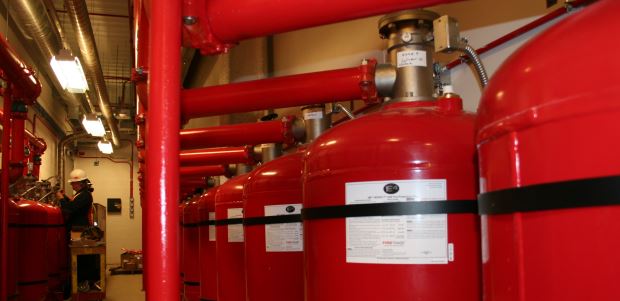
Greening Trends Are Red Hot in Fire Safety
Regardless of the agent or system used, fire systems are taking on a new look with the newest technology.
- By Gina Tedesco
- May 18, 2015
Green has symbolized safety for many years: safe practices, products, and techniques. Now, some of the very systems that keep us safe have become greener in an environmental sense, owing to the change in attitudes about protecting the environment.
Experts in the fire safety field say systems have advanced on many technological fronts. Frequently, these advances contain an eco-friendly dimension, as corporations and municipalities respond to calls from customers and constituents for greater sustainability.
"I can say without a doubt that leaders in the field are definitely taking the greenhouse gases and green approach very seriously. It's not just lip service; they're trying to do everything they can to protect the environment," said Paul Harris, past president of Fire Suppression Systems Association and past board member and director of business development of Americas for Xtralis, which provides early warning fire detectors.
Scott Starr, director of marketing for Firetrace, a manufacturer of fire suppression systems, agreed. "In more recent years, there's a greater awareness of green products and environmental impact, especially as more companies aim to reduce their environmental footprint. There's more value placed on being green in all of their operations, including fire suppression," he said.
The trend toward sustainability will be evident at the National Fire Protection Association's 2015 Conference and Expo, which takes place June 22-25 in Chicago. More than 300 exhibitors from around the world will display the latest and best in fire detection and suppression. Health, safety, and environmental professionals, along with those who design, install, and maintain fire systems, can see the newest ideas and devices, network with peers, and find solutions that meet their objectives.
As an example of green approaches in fire detection, Harris said the best way to minimize effects of a fire suppression agent on the environment is not to deploy it at all, if possible. He says the company's aspiration detectors actively draw air into a detection chamber for analysis, detecting any smoke that might be present sooner than waiting for it to waft into a detector on its own. If a unit detects wire insulation is overheating or another fire condition is brewing in a computer system, the detector can alert personnel in the pre-alert stage who might be able to shut the system down or take other steps to mitigate the problem. Failing that, the suppression system will still discharge when needed.
Harris noted the early detection buys time to investigate the problem and quite possibly avoid false alarms, which he says can be prevalent and waste time and resources.
In the field of suppression, more eco-friendly agents are available to fight fires, and some systems deliver the agents in more user-friendly ways. Halon, a staple of 1980s-era suppression, has given way to the cleaner DuPont ™ FM 200® and 3M™ Novec™ 1230 Fire Protection Fluid. With the latter having flow characteristics similar to water at room temperature, a Firetrace suppression system uses fewer and smaller pipes, reducing overall installation costs.
From the Netherlands, the EXXfire suppression firm has developed a system capable of producing nitrogen gas at room temperature. The company says its system produces no potential for global warming or ozone depletion, adding its agent is clean and leaves no residue.
Interest in eco-friendly systems has created a renewed interest in high-pressure water mist. One provider, Fogmaker North America, offers a system designed for vehicles (buses, rail stackers, and logging and mining equipment) that does not require electrical power. Mist effectively chokes off the fire’s oxygen supply. Because the agent is water, the company says it is environmentally friendly, with no hazardous materials involved; provides for easy cleanup; and does not harm people or machines.
There is No One-Size-Fits-All Solution
Experts say no one system or agent is right for all applications, however. "Clean agents are predominate choices where life safety and business continuity are key factors in the decision-making process. Carbon dioxide continues to be a viable option for specific applications," said Fred Hildebrandt, Janus Fire Systems' sales manager.
Starr agreed clean agents have applications where they are absolutely the best choice but that no agent is a one-size-fits-all solution. Regardless of the agent or system used, fire systems are taking on a new look with the newest technology.
With 3-D printers now creating everything from musical instruments to replicas of body parts, it's likely no surprise that one company, Amped I, has developed a technique to create fire nozzle rotors on a 3-D printer. This allows a developer to create an open-head nozzle for a compliant deluge water suppression system. The company also has been testing new fire suppression agents.
One can scarcely open an Internet browser without seeing an article describing another application for drones. At the NFPA conference, one educational session will focus on how a select few North American fire departments are testing drones for use in confined spaces, building collapse, and firefighting situations. "This rapidly evolving technology will very soon be valuable, practical, and cost effective for department use," said John Flynn, deputy fire chief of the Yonkers, N.Y., fire department and a conference presenter.
Sessions also will focus on green aspects of safety in natural and developed spaces. In "Fire Protection Design in the Wildland–Urban Interface," experts will discuss designs for new construction where urban areas are adjacent to wildlands. "Green Building's Impact on Firefighter Safety" will present an update on efforts to reduce firefighter injuries and deaths from unknown or unanticipated fire environments and structural responses associated with green building elements. For more information, visit http://www.nfpa.org/conference.